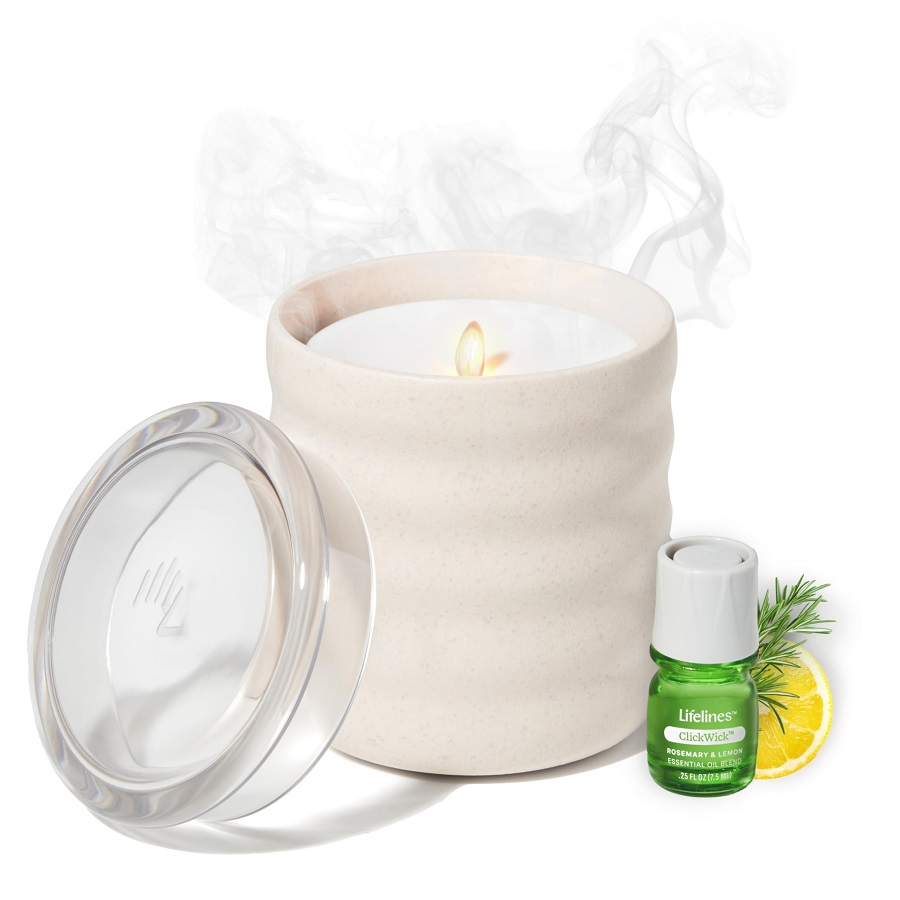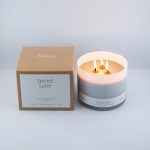Introduction to Essential Oils in Candle Making
Essential oils are natural extracts used widely in aromatherapy and cosmetic products. Their strong fragrances and therapeutic properties make them a popular choice for enhancing homemade candles. When you use essential oils in your candles, you incorporate a layer of natural aroma that can enhance the ambience of any space. However, it’s important to understand that not all essential oils work the same way in candle making. The process involves several considerations to ensure safety and effectiveness.
Types and Properties of Essential Oils
Essential oils come from various parts of plants, like flowers, leaves, and roots. Commonly used oils in candle making include lavender, lemon, cinnamon, and eucalyptus. Each oil has its unique scent and properties. For instance, lavender is known for its calming effect, while cinnamon offers a warming sensation. Selecting the right essential oil depends on the desired scent outcome and the oil’s compatibility with candle wax.
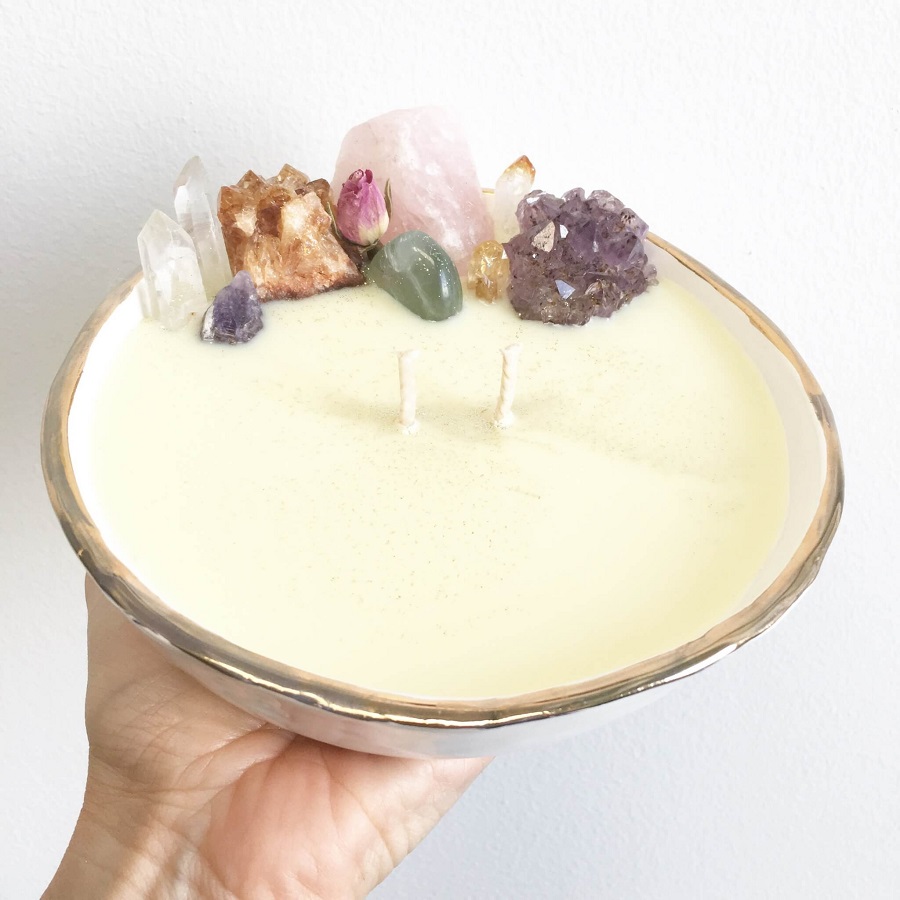
Benefits of Using Essential Oils in Candles
Using essential oils in candles can elevate the sensory experience, making your homemade candles not just a source of light but also a therapeutic tool. Here are some benefits:
- Natural Fragrance: Essential oils provide a natural way to scent your candles without synthetic chemicals.
- Therapeutic Properties: Many essential oils offer health benefits such as stress relief, energy boosts, and improved sleep, which can be imparted through candles.
- Customization: You can create custom scents tailored to specific needs or preferences, making your candles truly unique.
Precautions and Safety Measures
While essential oils add a natural scent to candles, safety is critical. Understanding the risks associated with essential oils can help you make informed decisions in your candle-making process.
Understanding CMR Substances in Essential Oils
Natural doesn’t always mean safe. Some essential oils contain CMR substances, which are Carcinogenic, Mutagenic, or Reprotoxic. When heated in candles, certain oils like lavender or cinnamon could release these harmful compounds. Always research and use essential oils known for being safer when heated.
Flash Points and Fire Safety
A key safety aspect of using essential oils in candles is their flash point. This is the temperature where oils can catch fire. Essential oils often have a low flash point, which increases the risk of ignition. To reduce this risk, use essential oils sparingly and keep combustion temperatures low. Proper measurement and attention to the flash point of the oils can prevent accidents and ensure a safe, enjoyable candle experience.
Choosing the Right Materials
Selecting the right materials is vital for successful candle making with essential oils.
Selecting the Best Waxes for Essential Oils
The wax you choose can affect your candle’s performance. Here’s what to consider:
- Soy Wax: Great for essential oils, soy wax has a lower melting point, which helps to distribute the scent evenly.
- Beeswax: A natural option that’s toxin-free. Beeswax has a higher melting point, which may mean a subtler scent release.
- Paraffin Wax: Offers a strong scent throw, but it’s not as natural as soy or beeswax.
Pick a wax that works well with the essential oils you plan to use, ensuring your candle burns properly and safely.
Essential Equipment for Candle Making
Having the right equipment is just as important as the materials. Here’s what you need:
- Double Boiler: To safely melt the wax.
- Thermometer: To monitor the wax temperature.
- Wicks: They must match the size of your candle jars.
- Stirring Tool: Like a wooden spoon, for mixing the wax and oils.
- Containers: For pouring and setting your candles.
- Protective Gear: Such as gloves and goggles for safety.
Gather these tools before starting your candle making to ensure a smooth and safe process.
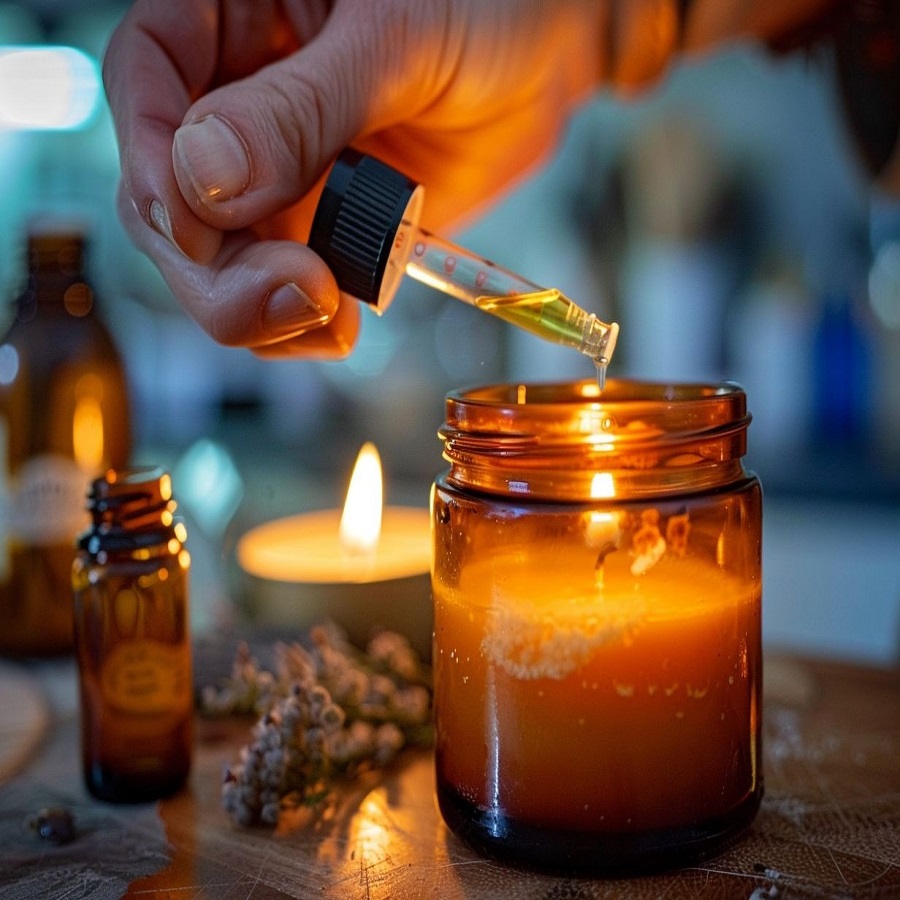
Making Your Scented Candles
Creating scented candles can be a fun and rewarding DIY project. With the added touch of essential oils, your candles will not only light up the room but also fill it with pleasant aromas.
Step-by-Step Guide to Making Candles
To start, collect all necessary materials like wax, wicks, and containers. Heat the wax using a double boiler until it melts completely, which usually happens at around 160-170 degrees Fahrenheit. Once melted, let the wax cool to an ideal temperature—below the flash point of the essential oils you’re using, usually between 120-140 degrees Fahrenheit. Attach the wick to the container’s base. When the wax is ready, pour it into the container carefully, leaving room at the top. Allow the candle to set and harden undisturbed for several hours.
Tips for Adding Essential Oils to Wax
Here are some short tips for infusing your candles with essential oils:
- Let the wax cool a bit before adding oils.
- Use 10-15 drops of oil per cup of wax, or adjust to preference.
- Stir the oil and wax mix gently for even scent distribution.
- Test your blend to ensure it smells right before adding to wax.
- Remember, more oil isn’t always better. Too much can cause the candle to smoke.
By following these steps and tips, you can enjoy handmade candles with custom scents perfect for various occasions or your personal use.
Crafting a Perfect Scent
Creating the perfect scent for your candles can be an exciting experience. Blending different essential oils allows you to achieve a unique and personal aroma. But, it’s not just about picking your favorite scents; understanding the art of blending can make a big difference. A good blend considers how different notes—top, middle, and base—work together.
How to Blend Essential Oils for Unique Fragrances
To create a harmonious blend, start with a base note oil. These scents are deep and rich, like vanilla or sandalwood. They last the longest. Next, choose a middle note. This is the heart of the fragrance. Floral or herbal scents like lavender or rosemary work well here. Lastly, add your top note. These oils, such as lemon or peppermint, are the first scent you smell. They give the blend an initial impact but fade quickly. Aim for a balance, using more base and middle notes compared to top notes. Mix them slowly, drop by drop, and let them sit before deciding if your blend is right.
Recommended Essential Oil Blends for Candles
Here are some popular blends to try. For something uplifting, blend citrus oils like orange or grapefruit with mint. For the holidays, cinnamon, clove, and orange create a warm, festive scent. Remember, essential oils are potent. Start with fewer drops and add as needed. Your own tastes are key; trust your nose when crafting your scent!
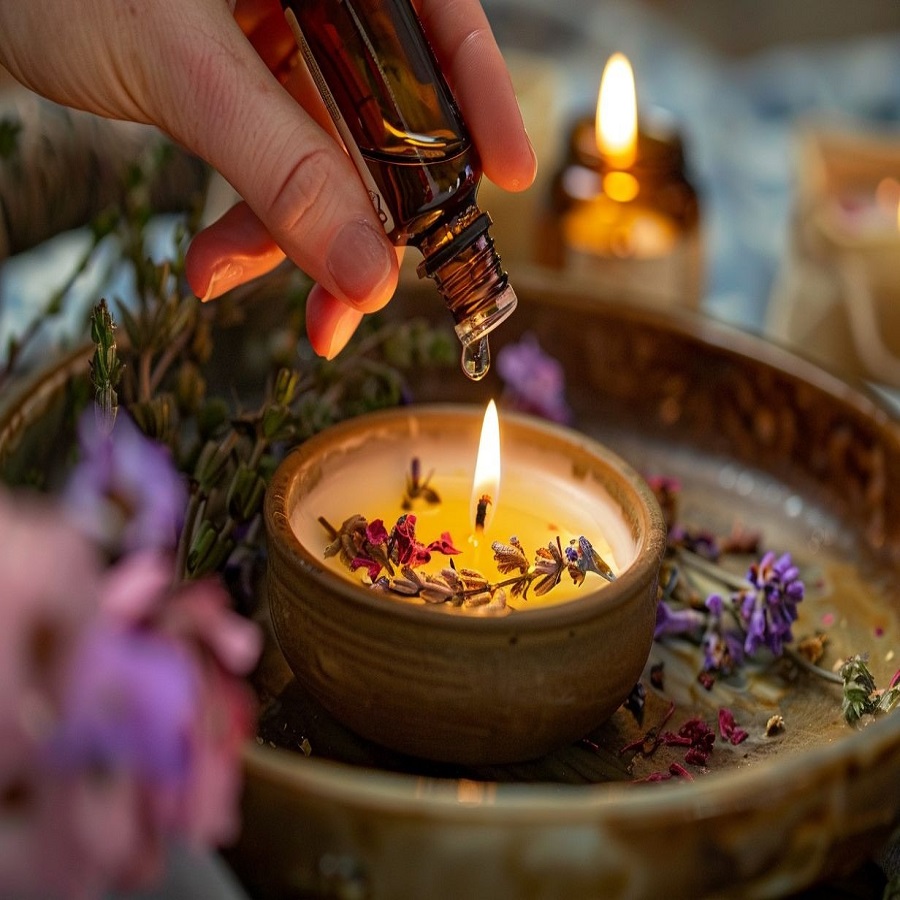
Alternatives to Essential Oils
While essential oils provide natural fragrances for candles, some drawbacks exist. These include potential safety concerns and inconsistent scent throw. Thus, seeking alternatives to essential oils can be beneficial for candle makers who prioritize stability and safety.
Benefits of Using Synthetic Fragrances
In situations where essential oils may pose risks, synthetic fragrances emerge as a strong alternative. They offer several advantages:
- Consistent Quality: Unlike essential oils, synthetic fragrances deliver a uniform scent profile.
- Better Scent Throw: They tend to have a more robust hot and cold throw, creating a pleasant aroma throughout the room.
- Higher Stability: Synthetic fragrances withstand higher temperatures without degrading, ensuring the candle’s scent lasts longer.
- Safety Tested: These fragrances undergo testing for safety, ensuring they are fit for candle making.
Making the Choice Between Natural and Synthetic
Deciding whether to use natural or synthetic fragrances in candle making depends on several factors:
- Safety: If you have concerns about the dangers of essential oils, such as their potential to release CMR substances, switching to synthetic fragrances might be preferable.
- Scent Strength: Synthetic fragrances typically provide a more powerful scent than essential oils, making them ideal for those who want a stronger aroma.
- Budget: While natural essential oils offer purity, they can be costly. Synthetic fragrances often come at a lower price, making them a cost-effective alternative.
- Ease of Use: The compatibility of synthetic fragrances with various waxes can make the candle making process smoother.
In conclusion, while essential oils have their appeal, the reliability and safety of synthetic fragrances make them a practical option for many candle makers.
Advanced Tips for Candle Makers
Managing Scent Strength and Longevity
Achieving the right scent strength is key for successful candle making. Here are some tips:
- Wax Type Matters: Soy wax holds scents longer than paraffin wax. Choose wisely for lasting scent.
- Correct Oil Amount: Too much essential oil can cause smoke. Start with fewer drops, adding more if needed.
- Proper Mixing: Thoroughly mix essential oils with wax to ensure even scent distribution.
- Curing Time: Allow candles to cure for at least 48 hours before use. This sets the scent.
By following these steps, you can create candles with lasting and robust fragrances.
Troubleshooting Common Candle Making Issues
Encountering problems during candle making is not uncommon. Here’s how to solve them:
- Weak Scent: Increase the amount of essential oil, but do not exceed the recommended fragrance load.
- Uneven Burning: Ensure the wick is centered and the wax is evenly distributed in the container.
- Soot Formation: Trim the wick to 1/4 inch before lighting. Keep the candle away from drafts.
- Candle Tunneling: Use a heat gun to melt the rim of extruding wax near the wick.
These fixes can help overcome typical candle making challenges, resulting in beautiful, functional candles.
